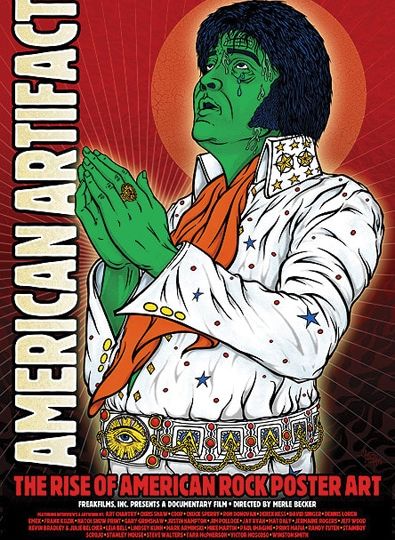
I’ve only recently had the income to even consider art collection as an option for me, but as a music fan, rock poster art has long been my medium of choice. With new avenues for emerging gig poster artists to share their work (the Flatstock poster art show and gigposters.com to name a couple) it’s very easy for a novice collector and enthusiast like myself to become educated about the scene.
With such a long and rich history, there is plenty of fertile ground for a historian to explore and recently filmmaker, Merle Becker explored this active community in the film American Artifact: The Rise of American Rock Poster Art.
[youtube=”http://www.youtube.com/watch?v=kNYQScvrDY0″]
Becker interviewed dozens of artists, from 60’s poster icon Stanley Mouse to contemporary artists (and local favorites of mine, Mat Daly and Jay Ryan) The film covers quite a bit of ground in a short period of time, moving from the San Franscico hippie scene, 80’s punk, 90’s grunge and the current indie rock poster scene in less than 90 minutes. For those new to rock poster art, it’s an effective and tantalizing primer to the world and a good entry point for new collectors as well.
I attended a screening of the film this weekend at the Gene Siskel Film Center in Chicago, which culminated with a Q & A with the director and a few local artists including Steve Walters, Jay Ryan and Mat Daly.
Fan labor and its impact is a continuing point of discussion here at The Learned Fangirl, so one of the things that stuck out for me during the film and the discussion afterwards is that most of the artists involved in this movement started their careers as fans, making posters for their friends or the bands that they admired. In many cases the posters were ade without the official approval of the band or the venue where theor performance took place.
When asked about any official/legal partnerships between poster artist and band, everyone on the panel stated revealed that little more than a handshake agreement bound them. During the film, it was stated that many of the early rock poster artists would approach fans and venue owners with their wares, eithre splitting the income that was generated from on-site sales or using the posters as a “value-add” (for lack of a better term) with concert tickets.
Contrast this live-and-let-live approach to fan laborers and content owners with the very aggressive crackdown on fanworks that we see from large media companies that we’ve talked about on the blog in the past.
Sometimes I get so caught up in looking at the impact of contemporary fanworks like fan videos and mash-ups, it’s easy for me to forget that the economic overlap between fan works and content creators certainly did not advent with the Internet.
Here’s evidence that fan labor has historically been beneficial for all parties involved, not just in developing a cultural movement that supports content creators/owners, but in creating and supporting a brand as a whole; the music industry seems to lead the pack and lag behind when it comes to interaction with fans. The three way continual push and pull between content creators/owners, marketing departments and their legal representation is a culprit for sure.
In light of the handshake deals between poster creators and bands, it’s especially interesting that one of the most important fair use cases revolves around the use of band posters. In 2006, in Bill Graham Archives v. Dorling Kindersley, the Second Circuit held that it was “fair use” to use seven Grateful Dead posters — as part of a large collage of similar images — in a cultural history of the band, Grateful Dead: The Illustrated Trip (2003).
Anyone else see the film? Thoughts about it, or the gig poster scene in general?

